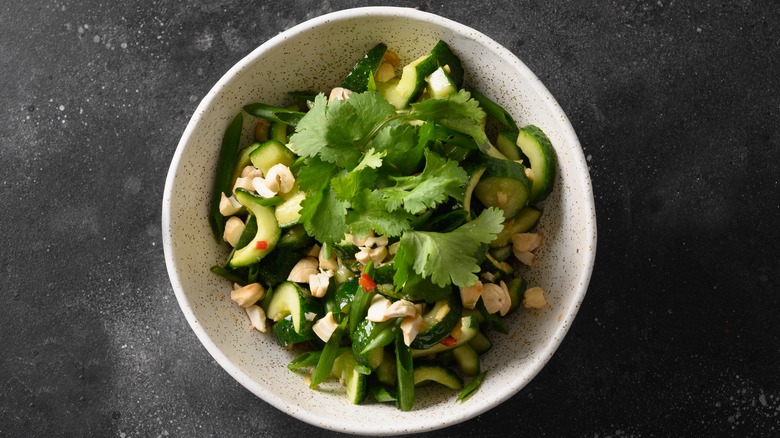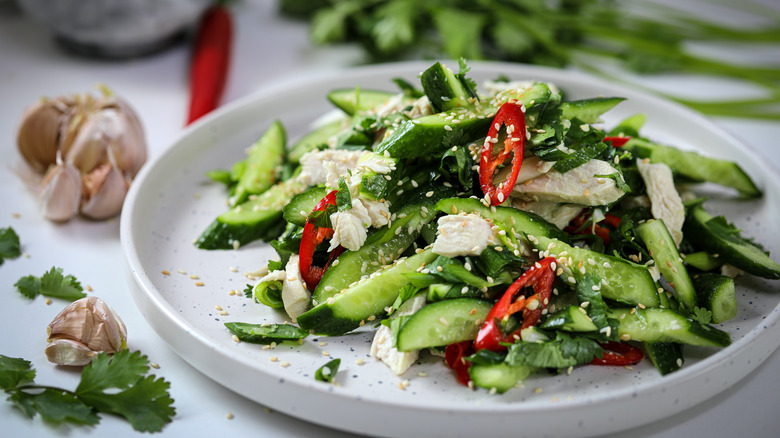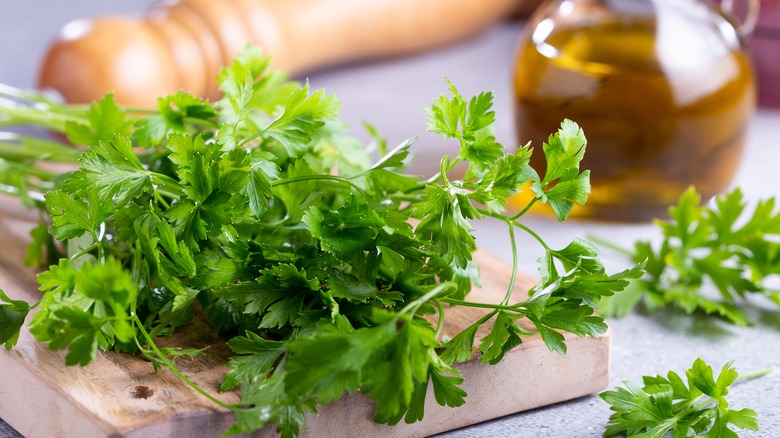Tiger Salad Is A Spicy, Herby Mix Sure To Boost Any Protein
We may receive a commission on purchases made from links.
When a meal needs to roar with flavor, it might be time to serve a plate of tiger salad. Although no animals are harmed with this recipe, the Chinese name Lau Hu Cai, gets its name from the Chinese word for tiger. Looking at the visuals for this vibrant green bowl of vegetables, some believe the animal references bold flavors while others suggest it is similar to the animal's mane. After enjoying a bite, bright, zesty notes perk up the palate, which can have people roaring in delight.
Although recipes and ingredients vary, generally the dish includes an herb, a crunchy textural component, and a bold seasoning. The herb is often cilantro, but it could be swapped for another leafy herb, like mint or basil. For the crunch, the ingredients are often celery, green pepper, cucumber, or another raw green vegetable. Lastly, the seasoning can come from a variety of sources. Whether it is a few red pepper flakes, a squirt of sriracha, or even a dollop of chili crunch, almost anything can be used to bring a touch of heat to the other bright flavors.
One thing is key for a tiger salad. Nothing is cooked. Given the warmth of the Northern China climate, the raw vegetables ensure that the flavor is bright and refreshing. For a zesty forkful that can cleanse the palate, tiger salad needs to be on the plate.
How to serve tiger salad?
Although the ingredients can vary, the green, herbal, spicy tiger salad has almost unlimited pairings. Since the salad is bright, refreshing, it helps to bring balance to a meal. Some cooks believe that the combination of sour, spicy, and herbal helps to stimulate the palate. When picking a protein to pair with this dish, it might be more about either personal preference or the particular setting.
For example, serving tiger salad with some sauteed shrimp can bring out the sweetness in the crustacean. Given that the salad can be spicy, consider a simple seasoning on the shrimp to allow each component to shine. A similar idea can be applied to chicken, white fish, or even pork.
When pairing with a heartier protein, like lamb, the herbaceous notes help to lift the game protein. Although tiger salad is often served with cilantro, swapping the herb for mint with a lamb pairing could be enjoyable. Given that lamb and mint are a scientifically proven pairing, it could add more versatility to the Chinese salad.
Given the simplicity of a tiger salad recipe, it can find its way into many cook's rotation. Also, it is a great way to use up any herbs or green vegetables in the refrigerator. Whether served as an appetizer, inter-mezzo, or with the main course, tiger salad could be a flavorful experience that leaves guests hungry for more.
Why is an herb salad a great palate cleanser?
Sometimes a meal is a flavor journey, but one that may not be a straight path. Bold flavors can inhibit the enjoyment of delicate ones. As MasterClass describes, palate cleansers help to offer a break, which allows the eater to distinguish between flavors. While some people might be familiar with a sorbet, herbs can be another choice. Whether it is cilantro, mint, or even parsley, that bright note is a welcome respite to the tastebuds.
Looking at Chinese cuisine, tiger salad, which is a plate full of herbs and green vegetables, can serve as that palate cleanser. Even though the herbs are dressed with some spice and oil, the freshness should not be overpowered. Restaurants like Xi'an Famous Foods is known for serving its version as a side to other dishes.
While tiger salad might be a Chinese dish, the concept of an herb salad is not limited to just one style of cuisine. Why can't a plate of celery, cucumbers, or green pepper combined with cilantro, mint, or parsley be dressed with some olive oil and some red pepper flakes? In the end, herbs can be more than just a finishing garnish. Put them as the star of the plate with a herb salad.


